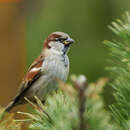Biology
provided by Arkive
House sparrows feed mainly on seeds, but in the breeding season the adults will take some animal matter (mainly insects), and feed their young on insects for the first part of the nestling period (9). It is a regular visitor to garden bird tables and feeders (5).
This sociable species nests in colonies, the untidy feather-lined nests are built in crevices and holes in buildings, tree holes and nest boxes (4). House sparrows are also known to occasionally evict other species of birds from their nests, subsequently occupying them (6). During the breeding season, house sparrows mate very frequently, so much so that their eggs were once highly prized as aphrodisiacs (6). After May, 3-5 whitish, blotched eggs are laid (4). The female incubates the eggs for up to 14 days, after which time both parents share the task of feeding the young for around 15 days (4). Three or more broods may be produced every breeding season (4).
The gregarious nature of this sparrow is often most obvious during winter, when most activities including feeding, roosting and bathing, are carried out in groups or large flocks (5).
Conservation
provided by Arkive
The decline in numbers of the house sparrow is of such great concern, that this bird has been 'upgraded' to the Birds of Conservation Concern Red List. The British Trust for Ornithology (BTO) is currently running a house sparrow appeal, in order to raise funds to carry out research and monitoring of the species in order to understand the pattern of decline (8). House sparrow numbers have more than halved over the past 25 years. To help find out why, the RSPB asked for volunteers across the country to take part in a survey of house sparrows. The survey, which ran from the 3-11 May 2003, saw a quarter of a million participants and just over 1 million house sparrows seen. A UK city league table for house sparrows was produced from the results collected. Lincoln came top with an average of 9.41 sparrows seen per home. London came last with an average of only 4.53 sparrows per home (9).
Description
provided by Arkive
The sparrow is one of Britain's most well-known and best-loved birds. Both sexes have a brown back streaked with black. Males and females are easily distinguished; males have a black bib, a grey crown with chestnut sides, and white cheeks. Females and juveniles have a duskier appearance, and lack the black bib seen in males (2). It is a very vocal species, producing a great range of familiar chattering and chirping, and a 'cher'r'r' when squabbling (2).
Habitat
provided by Arkive
Closely associated with permanent human habitations, including farmyards, villages, parks, suburban areas and city centres (4).
Range
provided by Arkive
Widespread throughout Britain, but has undergone a drastic decline during the last 25 years. There are regional differences in the decline, but it has been most severe in the east of England, with a shocking reduction of 90% since 1970 (8). Elsewhere, this cosmopolitan species is found throughout Europe, North Africa, the Middle East, India and Burma, and across central Asia. It has been introduced to New Zealand, Australia, and North and South America (4).
Status
provided by Arkive
Included in the Birds of Conservation Concern Red List (high conservation concern) (9). The house sparrow has undergone a drastic decline in the last 25 years; this is cause for conservation concern (3).
Threats
provided by Arkive
Suggested reasons for the decline of house sparrows include predation by domestic cats, changes in agricultural practices including the loss of seeds in winter and autumn, stricter rules concerning seed storage, (resulting in sealing of buildings) diseases spread at garden feeding stations, pollution (7), and loss of invertebrates to feed chicks in urban areas (9).

